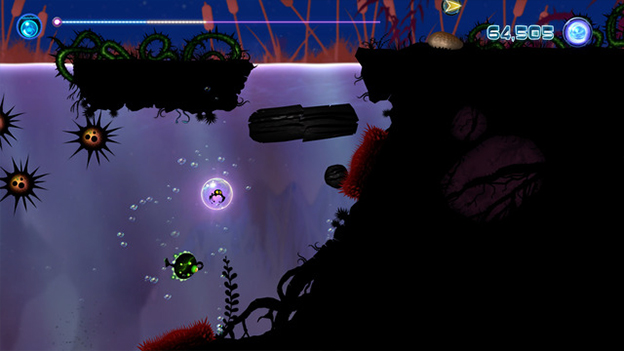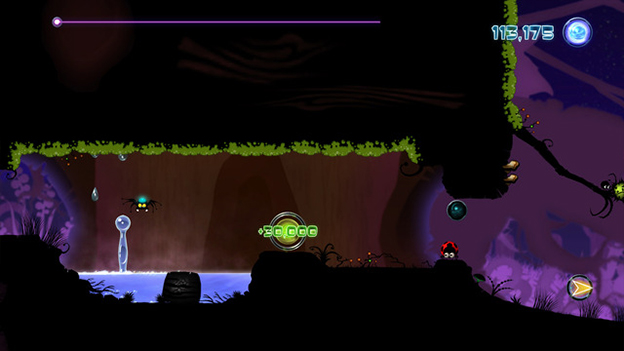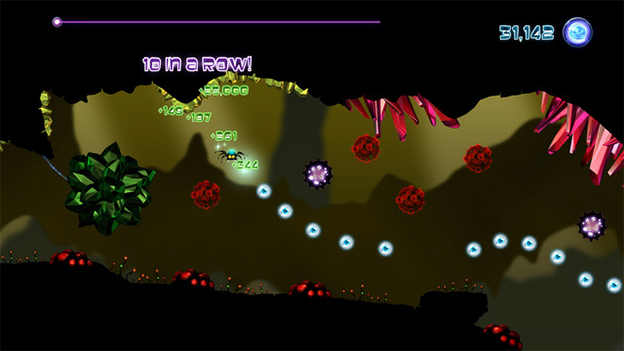Spinning A Dreadful Web
Alien Spidy is a terrific idea. You’ll play through larger-than-life, side-scrolling environments as a small extraterrestrial arachnid, using omni-directional webbing to swing from anchor points that you choose in the environment. It’s a translation of some of the best elements of Spider-Man 2, still the best wall-crawler game in gaming’s collective memory.
The plot, such as it is, resonates despite its simplicity. A hardware malfunction sets the heroic spider protagonist and his beloved pink spider-love astray from one another, and so, having crash landed on an unfamiliar planet, our hero must navigate terrain teeming with dangerous flora and fauna.
It all comes up aces with the visuals, which rely heavily on silhouettes and splashes of bright color, such as the azure rings upon your protagonist’s back. There’s a whimsical charm to the design, with the hero possessing big yellow eyes, extremely expressive, though he’s the only thing consistently seen in the game with such personality. The ladybugs you’ll often have to jump over, or use as mid-air grapple points, have eyes, but they seem fairly expressionless, staring blankly out of the screen.

Obstacle design is menacing enough, though. Thorny vines, brambles tumbling downhill after you, wasps that will cut your web mid-swing, and large bats that will endeavor to eat you whole are just a few of the foes you’ll encounter. Sometimes, when the game is in full swing, it can be somewhat difficult to pick out the safe from the deadly, but such occurrences are fairly rare. The strangest thing is that, though objects in the world appear to be polygonal, some of them obviously so, the manner in which the silhouette effect is used makes it appear to be 2D. It’s reminiscent of early 2.5D efforts, such as Strider 2 and Pandemonium.
Gameplay is fairly simple. Navigate each level without touching the various malefactors between you and the goal, collecting orbs and power-ups along the way. The orbs grant you points, especially if picked up in quick succession (though one must be wary of certain orbs, which instead subtract from the point total) while power-ups will do things such as provide a brief burst of speed, a super-high jump, or a brief period during which point orbs are attracted to your spider’s body.

The controls reflect the simplicity evident in the rest of the game’s design. Left stick moves the spider left or right, the A button jumps, and the right stick is used to shoot out a line of webbing in whatever direction it is tilted. This is immediate, and can be done in fairly rapid succession. Still, it is here, in the controls, that Alien Spidy begins to break down.
Response in Alien Spidy just feels off. The player’s avatar moves with inertia, which can actually lift him off the ground if he has to slightly shift levels in mid-step. Since he can’t jump in the air, this can throw jump timing off. Timing issues are already exacerbated by the floaty feel of the controls, but they’re certainly surmountable. Just adjust your response time a bit to accommodate, react a bit before you’d think you have to.

It becomes more problematic when the web-slinging controls are introduced into the equation. Flicking the right stick toward your desired anchor point is great in theory, but in practice, it’s inexact. I don’t know whether this is due to a lack of granular directional sensitivity on the action or because the game does nothing to “auto-aim” a web toward the obvious environmental object you’re trying to hook.
And the paths will be obvious. That much the game does very well, its level design and power-up layouts making it freely apparent just where one is supposed to go and what method one is supposed to use to get there, if not the specific timing of it. Confusion is certainly not the issue. Instead, it comes down to the timing and accuracy, which leads to a mad scramble after any jump where web-slinging is necessary, shooting out multiple webs in quick succession hoping to hook that vital anchor point before one’s momentum is too far off to successfully complete the motion one needs.
Maybe I’m just having problems with the aiming because I have to quickly move my right thumb from A button to right stick, flick the right stick, hop back to the A button so I can hop off the web-line at its peak, then bounce back ad nauseum. My brain has to take a bit of a shot in the dark every time I switch to firing webbing.
Or, more likely, I’m just spoiled by the seminal indie platformer Super Meat Boy. That was a game that proved that one-hit deaths can be fun rather than frustrating, even with absurdly dense level designs and a requirement for flawless high-speed, complex acrobatics. Super Meat Boy has short boards, though, and resets you immediately upon death, so the “well, one more try can’t hurt” drive kicks in and you keep playing. Alien Spidy displaces this with its checkpoint system.
Yes, the boards are longer, and they have mid-level checkpoints. That’s actually a bit of a plus, though, since it lowers the barrier to entry. You don’t have to web-sling perfectly through each level, collecting all (or most) of the point orbs in one run. If you flounder, you’ll just reset to the last checkpoint and, hey, if you’re less than satisfied with a run through a section of the level, the Y button will immediately teleport you back to the last checkpoint you passed.
So I figured I’d just take the game at face value. No, the platforming wasn’t perfect, with an absolutely infuriating web-aiming mechanic, but that was okay. I would take it at my leisure, and not worry about how poorly I performed in a given level. I made it through the sixteen levels of the first world and then tried to proceed onward.
I was locked to the first world.

Further inspection revealed the truth: A certain number of stars was necessary to progress. How were stars awarded? It was based on point total in a given level. Remember what I said about the checkpoints making things more leisurely? They’re actually your worse boon. Every time you return to a checkpoint, you lose all points collected since, less an extra 2,000. This results in a difficult section, or one in which you continually score poorly, setting you back tens of thousands of points. The point requirements for stars vary wildly by level, which is another problem, since it skews the game’s difficulty curve, but it holds mostly true that in order to do appreciably in any level, you must more or less make a straight, flawless shot from beginning to end, unmolested by the level’s dangers. While doing this, you must also collected almost all of the point orbs, and do so with enough rapidity to get the massive bonuses you receive for five and ten orb chains.
This leads to a lot of restarting. Again, that would be fine, except that restarting a level in Alien Spidy isn’t immediate. The “suicide” button only sends you back to the last checkpoint (less your 2,000 point teleportation fee). To restart a level, you have to pause, pick the “restart level option,” after which you’re booted to the loading screen before finally making it back to the start of the level, where it reminds you how many points you need to get the next star rating. Star ratings are out of five, but you’ll only start a level knowing how many you need for a two. Get a rating, and it’ll reveal the point value necessary for the next rank up. It’s a pointlessly obfuscated system.
All of this sucks the fun out of a potentially quirky and charming platformer. Alien Spidy is so close to being an enjoyable, active puzzle experience, but it lacks the fluidity, both in gameplay and in progression, that would allow it to be a truly memorable and engaging experience.
RATING OUT OF 5 RATING DESCRIPTION 4.0 Graphics
Definitely the best part of the game. “Charming,” “endearing,” and “quirky” all describe the aesthetic well, and the 3D-as-2D style just feels good. The camera sometimes lags behind where it needs to be on certain jumps, though. 1.5 Control
Floaty and imprecise, these represent by far my biggest issue with the game. 2.5 Music / Sound FX / Voice Acting
Nothing really stood out, whether for good or for bad. I did hear that teleportation sound far too many times, though. 2.0 Play Value
The biggest thing that will keep you playing is the star system that locks each of the zones behind an arbitrary number of stars in the preceding one. This isn’t like Mario 64 with its puzzle stars, though. Here, you know exactly what you must do, but are fighting against the controls to get it done. 2.3 Overall Rating – Poor
Not an average. See Rating legend below for a final score breakdown.
| Review Rating Legend | |||
|---|---|---|---|
| 0.1 – 1.9 = Avoid | 2.5 – 2.9 = Average | 3.5 – 3.9 = Good | 4.5 – 4.9 = Must Buy |
| 2.0 – 2.4 = Poor | 3.0 – 3.4 = Fair | 4.0 – 4.4 = Great | 5.0 = The Best |
Game Features:
